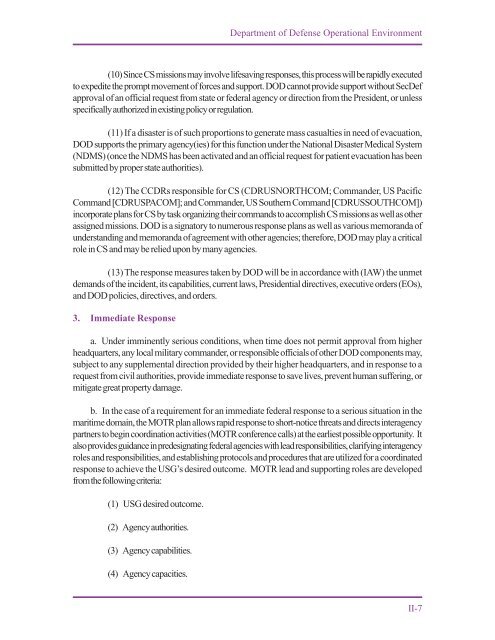JP 3-28, Civil Support - Federation of American Scientists
JP 3-28, Civil Support - Federation of American Scientists
JP 3-28, Civil Support - Federation of American Scientists
You also want an ePaper? Increase the reach of your titles
YUMPU automatically turns print PDFs into web optimized ePapers that Google loves.
Department <strong>of</strong> Defense Operational Environment<br />
(10) Since CS missions may involve lifesaving responses, this process will be rapidly executed<br />
to expedite the prompt movement <strong>of</strong> forces and support. DOD cannot provide support without SecDef<br />
approval <strong>of</strong> an <strong>of</strong>ficial request from state or federal agency or direction from the President, or unless<br />
specifically authorized in existing policy or regulation.<br />
(11) If a disaster is <strong>of</strong> such proportions to generate mass casualties in need <strong>of</strong> evacuation,<br />
DOD supports the primary agency(ies) for this function under the National Disaster Medical System<br />
(NDMS) (once the NDMS has been activated and an <strong>of</strong>ficial request for patient evacuation has been<br />
submitted by proper state authorities).<br />
(12) The CCDRs responsible for CS (CDRUSNORTHCOM; Commander, US Pacific<br />
Command [CDRUSPACOM]; and Commander, US Southern Command [CDRUSSOUTHCOM])<br />
incorporate plans for CS by task organizing their commands to accomplish CS missions as well as other<br />
assigned missions. DOD is a signatory to numerous response plans as well as various memoranda <strong>of</strong><br />
understanding and memoranda <strong>of</strong> agreement with other agencies; therefore, DOD may play a critical<br />
role in CS and may be relied upon by many agencies.<br />
(13) The response measures taken by DOD will be in accordance with (IAW) the unmet<br />
demands <strong>of</strong> the incident, its capabilities, current laws, Presidential directives, executive orders (EOs),<br />
and DOD policies, directives, and orders.<br />
3. Immediate Response<br />
a. Under imminently serious conditions, when time does not permit approval from higher<br />
headquarters, any local military commander, or responsible <strong>of</strong>ficials <strong>of</strong> other DOD components may,<br />
subject to any supplemental direction provided by their higher headquarters, and in response to a<br />
request from civil authorities, provide immediate response to save lives, prevent human suffering, or<br />
mitigate great property damage.<br />
b. In the case <strong>of</strong> a requirement for an immediate federal response to a serious situation in the<br />
maritime domain, the MOTR plan allows rapid response to short-notice threats and directs interagency<br />
partners to begin coordination activities (MOTR conference calls) at the earliest possible opportunity. It<br />
also provides guidance in predesignating federal agencies with lead responsibilities, clarifying interagency<br />
roles and responsibilities, and establishing protocols and procedures that are utilized for a coordinated<br />
response to achieve the USG’s desired outcome. MOTR lead and supporting roles are developed<br />
from the following criteria:<br />
(1) USG desired outcome.<br />
(2) Agency authorities.<br />
(3) Agency capabilities.<br />
(4) Agency capacities.<br />
II-7

















